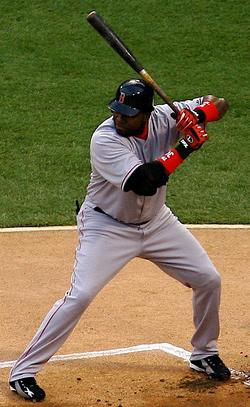 There was plenty of controversy this past offseason between David Ortiz and the Red Sox front office. Ortiz wanted an extension while the Sox wanted only to exercise their team option for the 2011 season, making Ortiz a free agent this coming winter. Ortiz was publicly upset over the matter and had his sights on proving all the nay-sayers wrong. To this point in the season, he has done that and more.
There was plenty of controversy this past offseason between David Ortiz and the Red Sox front office. Ortiz wanted an extension while the Sox wanted only to exercise their team option for the 2011 season, making Ortiz a free agent this coming winter. Ortiz was publicly upset over the matter and had his sights on proving all the nay-sayers wrong. To this point in the season, he has done that and more.
Ortiz heads into Tuesday with a .306/.378/.549 triple slash along with 11 home runs. However, he has done things a bit differently so far this season and the numbers are surprising to say the least.
In 2009, we all thought that Ortiz might be done for. He hit .238/.332/.462 with his highest strikeout rate since joining the Sox. After a bounce-back season in 2010, Otriz seemed to regain some of his former self, but still continued to regress with regard to contact rate and strikeout rate. To this point in 2011, Ortiz has a contact rate of 85 percent–above league average–and actually has more walks (23) than strikeouts (22). His strikeout rate is only 11.4 percent, which is about ten percent lower than his career average.
Basically, Ortiz, at least for the time being, is a near perfect hitter. He’s showing good plate discipline, not striking out much, hitting for AVG and hitting for power. The question is: Can he keep this up?
The answer to that question isn’t so cut-and-dry. Ortiz’s sample size of 217 plate appearances is OK, but not quite to the 300-350 mark that I’d feel more comfortable with. On top of that, his peripheral numbers are so drastically different than what we’ve grown accustomed to over the past few seasons.
What seemed like a natural regression for an aging DH–more strikeouts, less contact, slower bat-speed–has started out the complete opposite. However, one would have to think that Ortiz’s numbers will begin to normalize before long. Meaning that he should end up striking out a bit more, if nothing else. But even that may not be the case. Ortiz is playing for a contract after this season and he doesn’t want to fall into the same boat that Vladimir Guerrero did this past offseason, getting shunned by the Rangers and settling on a one-year $8 million dollar deal with the Orioles. It has been made quite clear by Ortiz himself that he wants the security of a long-term deal. That motivation alone could end up holding his numbers strong all season.
It’s not as if Oritz has been abnormally lucky either. His BABIP is .298 and he has registered a 20-percent line-drive rate to this point. Even his HR/FB rate of 15.3 percent is in line with his career numbers. Back in 2009, Ortiz had a problem hitting too many pop-ups. That has certainly not been the case this season, as Ortiz’s fly-ball rate is at about 42 percent, about three percent under his career average and his infield pop-up rate is at about seven percent, one percent below his career average.
If Ortiz were to maintain his current home-run pace, he would end up with about 29 homers in 500 at-bats. Given how healthy Ortiz has looked this season, could very well be approaching 550 or more at-bats by the end of the season.
Unlike the past two seasons, Ortiz has not struggled early on. Last season he hit .143/.248/.286 with one home run in April. This season he hit .267/.373/.395 with two home runs in April and has followed that up with a .336/.383/.673 line and nine home runs so far in May.
And what about his inability to hit lefties? Ortiz has hit .278/.391/.444 with two home runs in 64 plate appearances against lefties this season. He had only two home runs against left-handed pitching all of last season (200 plate appearances). Problem solved?
What Ortiz has done so far in 2011 is both surprising and unsurprising at the same time. After hitting 32 homers last season, we all figured that Ortiz would continue to hit for power this season. However, I don’t know if anyone expected him to improve so incredibly with regard to his contact rate and strikeout rate. If he maintains his current BB/K rate all season, he is going to end up putting the Sox brass in a tough spot. They clearly saw risk in giving Ortiz a long-term deal this past offseason and I’d imagine that at least some of that sentiment would remain regardless of Ortiz’s 2011 performance.
Health, of course, will play a role and there is certainly a scenario that sees Ortiz falling of a bit in the second half, but to this point, as I stated earlier, Ortiz is a near perfect hitter.
